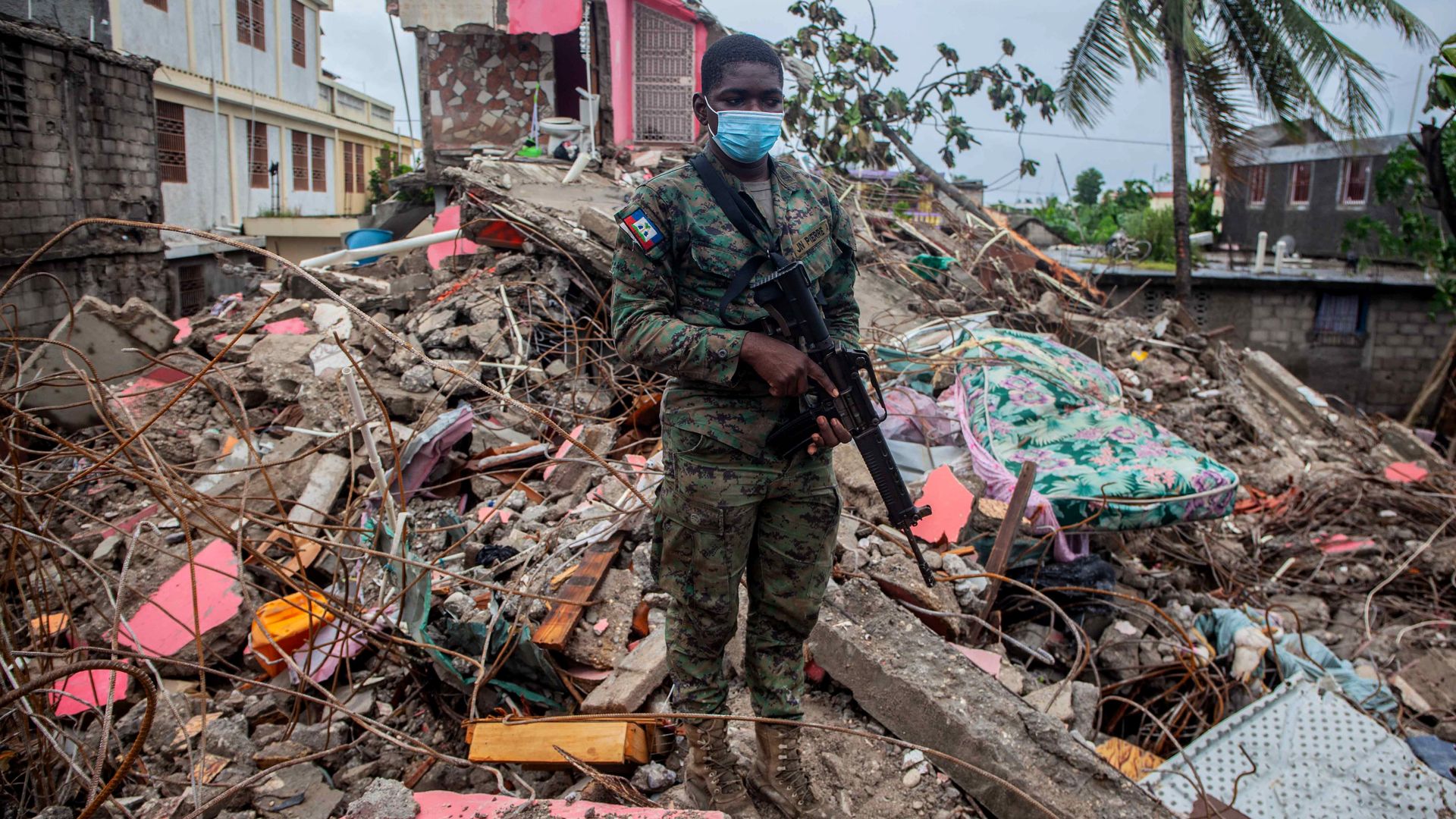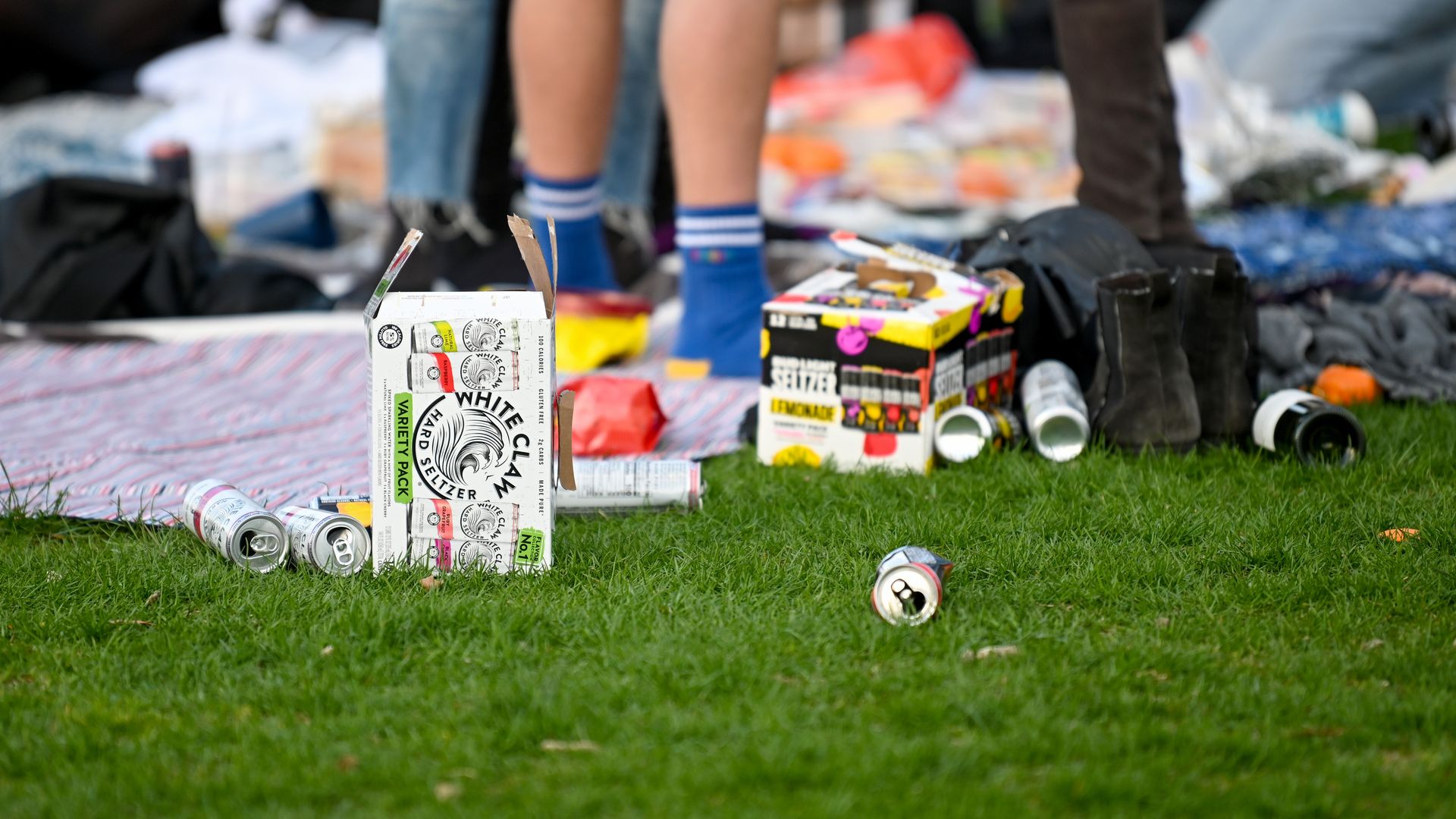| |
| |
| |
| Presented By WEST MONROE |
| |
| Axios Future |
| By Bryan Walsh ·Aug 18, 2021 |
| Welcome to Axios Future, where we are back on Wednesdays again as well as Saturdays. 🚀 Axios podcasts are going to space! The prologue for "How it Happened: The Next Astronauts" is live now — listen and subscribe here. Today's Smart Brevity count: 1,436 words or about 5 minutes |
| |
| |
| 1 big thing: The reality of the disaster divide |
 |
|
| A soldier stands over rubble in Les Cayes, Haiti, on Aug. 17. Photo: Richard Pierrin/Getty Images |
| |
| Disasters like the earthquake that struck Haiti on Aug. 14 are caused by nature but exacerbated by human inaction. Why it matters: Natural disasters will always be with us — and some will be worsened by the effects of human-made climate change — but it's well within our power to keep them from becoming mass killers. Driving the news: The 7.2-magnitude earthquake that struck southwestern Haiti has affected more than 1 million people and killed at least 1,941, though the number will surely rise in the days and weeks ahead. What's happening: Much of Haiti's vulnerability stems from geographical factors that can't be changed — its location in the Caribbean puts it frequently in the path of tropical storms like the one that struck just days after the Aug. 14 quake, while it also sits on multiple seismic fault zones. - But what makes those disasters such killers has less to do with geography than with the country's extreme poverty and resulting inability to invest in preparation and adaptation to those risks.
- According to the 2020 World Risk Report by the United Nations University, Haiti ranked 22nd overall in the world for risks from natural disasters, but ninth in lack of coping capacities — the ability to respond to a disaster — and eighth in lack of adaptive capacities.
Be smart: What's true of Haiti is true of the world more generally — what makes an earthquake or a storm or a flood or a drought truly deadly is poverty and everything that comes with it. - That's one reason why a richer and better-prepared region like the Bay Area in California can suffer a 6.9-magnitude quake in 1989 and lose 63 people, while Haiti lost hundreds of thousands in 2010 after a quake that was just slightly stronger.
The big picture: In the early to mid-20th century, the annual global death toll from disasters often reached 1 million or more per year, but over the past decade, the death toll has rarely risen above 10,000 per year. - The decline is even more impressive against the rate of global population growth — even as billions more people have been added to the planet, they're less likely to die in disasters.
- And while the economic toll of natural disasters has generally risen over the past 40 years, that's in large part a function of a much richer world having more property in harm's way, with the result being that disaster losses as a share of global GDP have declined along with deaths.
What's next: While wealth is a powerful shield, it's not impenetrable, and climate change is likely to amplify many kinds of disasters in ways that severely stress rich countries — and punish poor nations even more. Share this story |
    |
| |
| |
| 2. AI's shaky foundations |
 |
|
| Illustration: Sarah Grillo/Axios |
| |
| A new academic group is sounding a warning about powerful, if poorly understood, AI systems that are increasingly driving the field. Why it matters: New models like OpenAI's text-generating GPT-3 have proven so impressive that they're serving as the foundation of further AI research, but that risks propagating the biases that may be built into these systems. What's happening: This morning, a group of more than 100 researchers released a new report on the "opportunities and risks" of foundational AI systems as part of the launch of a new group at Stanford University called the Center for Research on Foundation Models (CRFM). - The report warns that the very qualities that have made these models so exciting — and potentially so commercially valuable — creates what Percy Liang, a Stanford computer science professor and the director of CRFM, calls "a double-edged sword."
- "We're building AI infrastructure on a handful of models," he adds, but our inability to fully understand how they work or what they might do "means that these models actually form a shaky foundation."
How it works: With these systems, "you just grab a ton of data, you build a huge model, and then you go in and discover what it can do," says Liang. - As an AI scientist, he adds, the power of these models is "so cool," but they also risk homogenizing the AI field.
- Any biases in these models — or in the data they're built upon — "risks being amplified in a way that everyone inherits," says Liang.
The bottom line: The good news is this foundation is still being built, so interdisciplinary groups like CRFM can work to study those defects and hopefully correct them. - The bad news is that we may be running out of time to do just that.
Read the entire story |
    |
| |
| |
| 3. New report calls for stopping human pandemics at the animal source |
 |
|
| Skulls of moray eels hang in a seafood market in Shanghai. Photo: Edwin Remsberg/VWPics/Universal Images Group via Getty Images |
| |
| A Harvard-led scientific task force argues it would be far less expensive to prevent the next pandemic by stopping the spillover of animal pathogens to humans. Why it matters: Though it's still unclear precisely how COVID-19 originated, scientists know most emerging human diseases begin in animals. - Actions to stop spillovers could reduce the chances of future pandemics while preserving the environment.
Driving the news: A paper published in Science this week makes the case that SARS-CoV-2 most likely originated in a spillover event from an infected animal in one of Wuhan's live animal markets. - That's still far from certain — other possibilities include a lab leak from the Wuhan Institute of Virology or even a direct infection from a bat — but the overall risk from spillovers is clear.
By the numbers: A new report out today from Harvard's Scientific Task Force to Prevent Pandemics at the Source notes that an estimated 50% of emerging infectious diseases over the past 50 years originated in wildlife, including HIV, SARS, Zika and 2009's H1N1 flu pandemic. - The rate at which those new diseases have been emerging is increasing, driven by deforestation — which brings more humans into contact with potentially disease-carrying animals — wild animal trade and consumption, and industrial animal farms.
But, but, but: The world currently spends less than $4 billion a year addressing those drivers of spillover — a minuscule percentage of the still-growing economic costs of COVID-19 alone. - "We're spending more on trying to develop pan-coronavirus drugs than we are on actions that could prevent pandemics from all kinds of viruses," says Aaron Bernstein, director of the Harvard task force.
Details: The task force calls for investments in conserving tropical forests, improving biosecurity in large livestock farms — which can amplify diseases that originate in wild animals — and establishing intergovernmental partnerships around spillover risk that include both human and animal health experts. - Researchers could assess blood samples from humans in viral hotspots who regularly come into contact with wild animals, in the hopes of identifying and arresting spillovers before they go global.
What to watch... whether funding for such "One Health" approaches is included in pandemic preparation bills being discussed in Congress. Share this story |
    |
| |
| |
| A message from WEST MONROE |
| Tomorrow's digital leaders will do five things differently |
| |
 |
| |
| Need a C-suite role for digital? We don't think so. Digital leaders rarely have a singular head of digital — opting for multidisciplinary digital leadership across the org instead. That makes it everyone's job to think digital. That's one thing digital leaders do differently. Here are the rest. |
| |
| |
| 4. The youth still like their hard seltzer |
 |
|
| Hard seltzer empties are scattered at an Easter party in New York's Central Park. Photo: Alexi Rosenfeld/Getty Images |
| |
| A new survey of college students finds the hard seltzer trend isn't going away. The big picture: The shift among young adults toward spiked seltzers — and away from cheap beer — will prompt lasting changes in the alcohol industry. By the numbers: After a pandemic boom, recent sales data indicates interest in hard seltzer brands might be slowing, with the spiked seltzer maker Boston Beer warning in late June that earnings would come in below analyst forecasts. Yes, but: No one has told college kids about that. - Respondents in a survey of college students' drinking preferences and brand perception from the polling and research firm Generation Lab were asked to rank 13 alcoholic brands — a mix of beers, wines and hard seltzer.
- The results show that seltzer industry leader White Claw was seen as the coolest brand, while White Claw and its rival Truly were viewed as "on the rise."
Read the rest |
    |
| |
| |
| 5. Worthy of your time |
| Bad news: Selling the story of disinformation (Joseph Bernstein — Harper's) - A fascinating piece that argues disinformation has less to do with the online world, and more to do with us.
The dangerous ideas of "longtermism" and "existential risk" (Phil Torres — Current Affairs) - An argument that focusing too much on the far future risks excusing injustices in the here and now.
Laser fusion experiment unleashes an energetic burst of optimism (Kenneth Chang — New York Times) - New advances mean that nuclear fusion — the perpetual power of the future — could actually become the power of the near future.
How data science pinpointed the creepiest word in "Macbeth" (Clive Thompson — OneZero) - It's "the." (Saved you a click.)
|
    |
| |
| |
| 6. 1 robot thing: Practice makes perfect (sort of) |
| Credit: Boston Dynamics Videos are circulating this week of Boston Dynamics' Atlas robots completing a parkour course. It's impressive! - But, but, but: Like humans, robots can't learn complex physical movements without a few, uh, missteps along the way.
|
    |
| |
| |
| A message from WEST MONROE |
| Leading companies treat digital as a mindset, not a project |
| |
 |
| |
| Digital transformation projects fail — your business either has a digital mindset, or it doesn't. What this means: - Treat digital as a team sport.
- Solve business challenges, not technical needs.
- Organize around the customer.
- Never stop adapting.
Learn how to become a digital business. |
| |
 | | It'll help you deliver employee communications more effectively. | | |










No comments:
Post a Comment